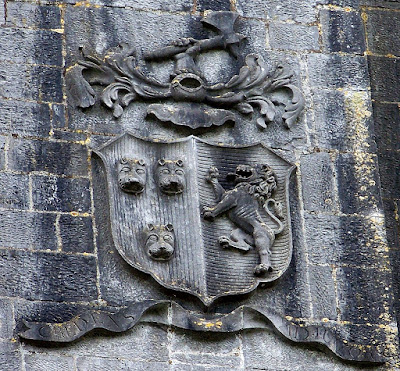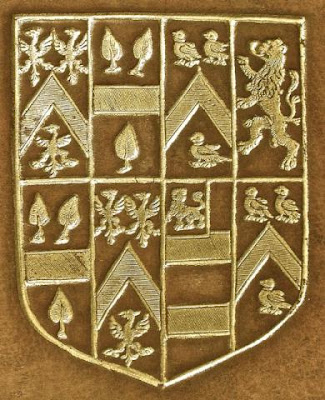There has been a castle on the Parsonstown (Birr)
site since 1170, and from the 14th to the 17th century, it was in the ownership
of the O’Carroll family. Following the death of Sir Charles O'Carroll, Sir
Laurence Parsons (who died in 1628) was granted Birr Castle and lands in
1620. After the death of Sir Laurence Parsons and of his elder son Richard, the
castle passed to his younger son William. After the civil war in 1641,
William's son Laurence refurnished the castle. Laurence Parsons, second Earl of Rosse (1758-1841) also engaged in some re-building in the early 19th
century when the castle acquired its Gothic look. This is reflected through the impaled Parsons and Lloyd arms for the second Earl and his wife, Alice Lloyd, to which we will return.
Their son, William Parsons
(1800-67), constructed the great telescope at Birr. When completed in 1845, it
was the largest telescope on earth, and capable of capturing more light and
seeing further into space than any telescope had done before. Birr therefore
became a focus for astronomical observations, and visitors came to visit the
observatory from all over the world. After the death of the fourth earl in
1908, the telescope fell into disrepair; the mirror was taken to the Science
Museum in London, and circa 1914 the telescope's metal supporting structure was
melted down to be used in the First World War. In 1925 the wooden structures
around the walls were demolished for safety reasons. Following several
intermediate restoration attempts, the telescope was restored more completely
in the late 1990s.
The Birr Castle website can be visited at:
On Friday 23 June 2017, the County Louth Archaeological & Historical Society spent an enjoyable few hours at the castle. It has a whole treasure trove of heraldry. Photography was permitted outside the castle so some of the heraldry from that perspective is examined here.
Gateway at Birr
This gateway leading into the main castle was built after the marriage in 1836 of the third Earl, William Parsons (1800-67) to Mary Wilmer-Field, a Yorkshire lady whose home was at Heaton Hall, just outside Bradford. His parents, from reasons of health and advancing age, handed over Birr Castle and went to live in the salubrious climate of Brighton. We will return to the heraldry on the gates. A very interesting article (1968 by the Earl of Rosse) on the third Earl is available on-line at:
Arms of Parsons on a gateway at Birr
The Parsons arms along with the coronet for an Earl and motto 'Pro Deo et Rege' are displayed over the entrance on the gateway. The blazon or the heraldic description for the achievement of arms of the Earl of Rosse follows:
The blazon is taken from the Armory (Sir Bernard Burke 1884). The full achievement of arms comprising the arms (shield), supporters, Earl's coronet, crest and motto is shown below. It is taken from:
Even though the blazon above gives the crest as a cubit arm holding a sprig of roses, Cracroft's Peerage gives a demi pole axe erect gules pointed or. Cracroft is also a good reference for a summary of the family members, from the first Earl onwards.
Entrance to Birr Castle
Two impaled shields can be seen higher up, over the doorway. An impaled shield represents the arms of both the husband and wife on the same shield. The one to the right carries the Parsons arms along with those of Lloyd (azure a lion rampant or) for the second Earl, Laurence Parsons and Alice Lloyd as we mentioned earlier who embarked on building work in the early 18th century. They were married c. 1797.
The impaled arms of Parsons and Lloyd.
The arms of Lloyd.
The terms for the colours silver (white), gold (yellow), blue, red, black, green are argent, or, azure, gules, sable and vert in heraldry. Notice above the vertical lines on the Parsons arms, these represent gules (red) while the horizontal lines on Lloyd represent azure (blue).
We turn next to the first family member to settle in Birr. The impaled shield on the left represents Sir Laurence Parsons and his wife Jane Malham. He settled in Ireland in 1611 and was made attorney general
for the province of Munster and was knighted, 1612. He married Jane Malham from
Yorkshire and he died in 1628. Sir Laurence appears to have been a second son, as
shown by the presence of a crescent shape as a mark of cadence for a second
son. His brother, Sir William Parsons also arrived in Ireland c. 1590 and he
was Commissioner of Plantations. He was Member of Parliament (M.P.) for
Newcastle, Co Dublin between 1613 and 1615. He was knighted in 1620. He was
created 1st Baronet Parsons [Ireland]
on 10 November 1620. He was Member of Parliament (M.P.) for Co Wicklow between
1639 and 1648. He held the office of Lord Deputy [Ireland]. He held the office
of Lord Justice [Ireland] between 1640 and 1643, jointly, when he was dismissed
and imprisoned for suspected treason. Further family details can be found at:
The impaled arms of Parsons and Malham.
The arms of Malham
The arms and blazon for Malham.
We return to the gateway, shown above, leading into the main castle. It was built after the marriage in 1836 of the third Earl, William Parsons (1800-67) to Mary Wilmer-Field of Heaton Hall in Yorkshire.
The left hand side of the gate carries the arms of the Earl of Rosse along with the supporters, motto and Earl's coronet. Higher up on the same side of the gate are the arms of Savage, Sprigg, Clere along with those of Parsons.
The arms, supporters and motto of the Earl of Rosse
The arms of Savage, Sprigg, Clere along with those of Parsons.
These arms represent the marriages of:
Sir William Parsons, 1st Baronet to Frances Savage
Sir Laurence Parsons, 3rd Baronet to Mary Sprigg
Sir William Parsons, 4th Baronet to Mary Clere
Arms of Savage
The arms and blazon of Sprigg
The arms and blazon for Clere
Next we turn to the right hand side of the gate that carries the arms of the Earl of Rosse along with the supporters, motto and Earl's coronet. The smaller shield superimposed on the main one represents the inescutcheon of pretence, the arms of Field. The smaller shield represents the Field arms for Mary Wilmer-Field, wife of William Parsons, third Earl of Rosse. Higher up on the same side of the gate are the arms of Baskerville, Thweng, Wilmer along with those of Field. In a sense the gateway represents the union of Parsons (on the left) with Field (on the right). The arms, already discussed, of some of the Parson ancestral families are displayed higher up on the left hand side and now we look at those ancestral families of Field on the right hand side.
The arms, supporters and motto of the Earl of Rosse
along with the inescutcheon of pretence for Field.
The arms of Baskerville, Thweng, Wilmer along with those of Field.
These arms represent the marriages of:
Field for Mary Wilmer-Field who married William Parsons, third Earl of Rosse
Wilmer for her mother, Mary Wilmer who married Joshua Field.
Baskerville for Rebecca Baskerville who married George Wilmer, great-grandfather of Mary Wilmer
Thweng for Margery Thweng, daughter of Marmaduke Thweng and wife of George Wilmer (father of the previous mentioned George).
The arms and blazon for Field
The arms and blazon for Wilmer
The arms and blazon for Thweng
The arms and blazon for Baskerville
A Thweng-Wilmer Book Plate













































